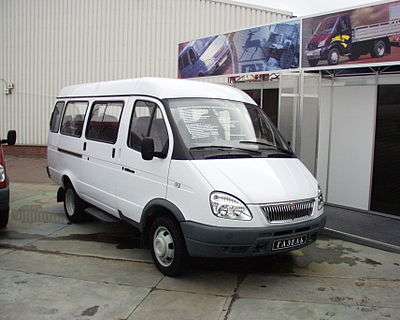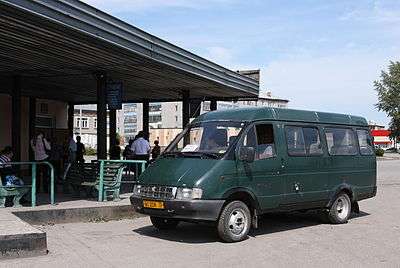GAZelle
| GAZelle | |
|---|---|
 GAZelle with the restyled front end introduced in 2003 | |
| Overview | |
| Manufacturer | Gorky Automobile Plant |
| Production | 1994–current |
| Assembly |
|
| Body and chassis | |
| Class | Light commercial vehicle (M) |
| Body style |
2-door dropside truck 2/4-door pickup truck 4-door panel van 4-door minibus |
| Layout | FR layout |
| Powertrain | |
| Engine |
|
| Transmission | 5-speed manual |
| Chronology | |
| Successor | Gazelle NEXT |
The GAZelle (Russian: ГАЗе́ль) is a series of light commercial vehicles: pickup trucks, vans and minibuses made by Russian car manufacturer GAZ. GAZelle, together with its lighter version Sobol, account for the majority of the Russian van and light truck market, has strong positions on the markets of CIS countries and rank as GAZ's most popular and successful products.
In 2010-2011 the GAZelle family underwent serious upgrade. The upgraded model got the name GAZelle Business. The changes affected 20 main vehicle units and systems, including steering, brakes, gearbox, cooling system, transmission and interior.[1]
In 2013 GAZ started serial production of the new generation GAZelle NEXT light commercial vehicle.
Generations
| Name | Data | Photo |
|---|---|---|
| GAZelle | 1994- Start of production of the first generation. Initially released only freighters.
1996- Started production of minibuses 1998- started producing cars Sobol |
 | | |
| GAZelle | 2003- Started production of the second generation. Changes: new teardrop-shaped headlights instead of rectangular, new grille, new front bumper, increased space under the hood, rear colorless lenses turning lights, combined with the reversing light lenses. A new dashboard and power steering, steel versions are available with all-wheel drive.
2004- appeared ABS 2006- side repeaters turning lights moved from the front wings to the side mirrors, which were painted body color |
 | | |
| GAZelle-Business (ru) | 2010- Scale modernization, construction of 130 made changes including: a new grille combined with the bumper. Inside, a new family of vehicles differ from their predecessors a front panel, steering wheel, standard audio head unit from Blaupunkt, new cab heater control unit or the front of the cabin.
Engine UMZ -4216 ( fresh family car commercial - UMZ - 4216.10 ) got a new injection control program, whereby the maximum torque ( 220.5 Nm) is achieved at fairly low for gasoline engine 2500 rpm . The family of " GAZelle Business " engine mountings were introduced Anvis Group, radiator with aluminum core TRM, Bosch electrical components and Brisk spark plugs. The drive brakes used products Bosch ( in particular, the brake master cylinder and the brake servo ), the drive clutch - components and ZF Sachs, were also introduced power steering from ZF Lenksysteme and defroster door mirrors as standard . New modification of the car with 2010 was equipped with a turbocharged diesel engine Cummins ISF American development . 2011- In the factory catalog appeared shuttle van with high roof. 2013- Started producing modifications with bi-fuel petrol-gas engine. |
|
| GAZelle Next | 2013- started production of a completely new LCV, while the production of the 2010 version continues. |  | | |
Models
- GAZ-3302 dropside truck and chassis, rear-wheel drive, regular three-seat cab
- GAZ-33021 dropside truck and chassis, improved, RWD
- GAZ-33023 dropside truck and chassis, all-wheel drive
- GAZ-33027 dropside truck and chassis, six-seat "King Cab" extended cab, RWD
- GAZ-330237 dropside truck and chassis, extended cab, AWD
- GAZ-3221 minibus, 8 seats, RWD
- GAZ-32213 minibus, 13 seats, RWD
- GAZ-322132 minibus, 13 seats (marshrutka, for shuttle services), RWD
- GAZ-2705 panel van, RWD
- GAZ-27051 ambulance, RWD
- GAZ-27052 Combi panel van, extended cab, RWD
- GAZ-27057 Combi panel van, extended cab, AWD
Variants
The GAZ Sobol is a lighter duty version of the GAZelle, built on a shorter wheelbase. It was introduced in 1998.
The GAZ Valdai is a heavier duty version of the GAZelle, built on a longer wheelbase. It was introduced in 2003.
Trim levels
Before the 2010 upgrade, customers were not given the opportunity to select options. Currently the Gazelle-Business can be ordered with a differential lock, ABS braking system, "Lux" instrument panel, and the No2 Package option (includes fog lights, electroproof mirrors, front electric windows, dashboard "Lux" (radio control buttons on the steering wheel and audio package), central locking front doors).
The 2013 Gazelle NEXT has its own system with the three basic trim levels and a set of options.
Gallery
.jpg) GAZelle Next ambulance
GAZelle Next ambulance GAZelle 2705 school bus
GAZelle 2705 school bus A white GAZ-322133 GAZelle marshrutka
A white GAZ-322133 GAZelle marshrutka- Ambulance in Kharkiv
 Ambulance in Tomsk
Ambulance in Tomsk- GAZelle in Prague
.jpg) The shorter GAZ Sobol as a police van
The shorter GAZ Sobol as a police van- GAZelle-Business(2010–present)
 A firefighting GAZelle van in Saratov
A firefighting GAZelle van in Saratov.jpg) GAZ-27527 Sobol all-terrain vehicle
GAZ-27527 Sobol all-terrain vehicle.jpg)
- Pickup truck
See also
| Wikimedia Commons has media related to GAZelle. |
References
- ↑ "GAZ Group has started serial production of upgraded GAZelle-Business" (Press release). GAZ Group. 2010-02-25.
External links
- GaZ's official GAZelle Page (English)
- Official site of plant in Turkey
- Club car owners Gazelle (Russian)